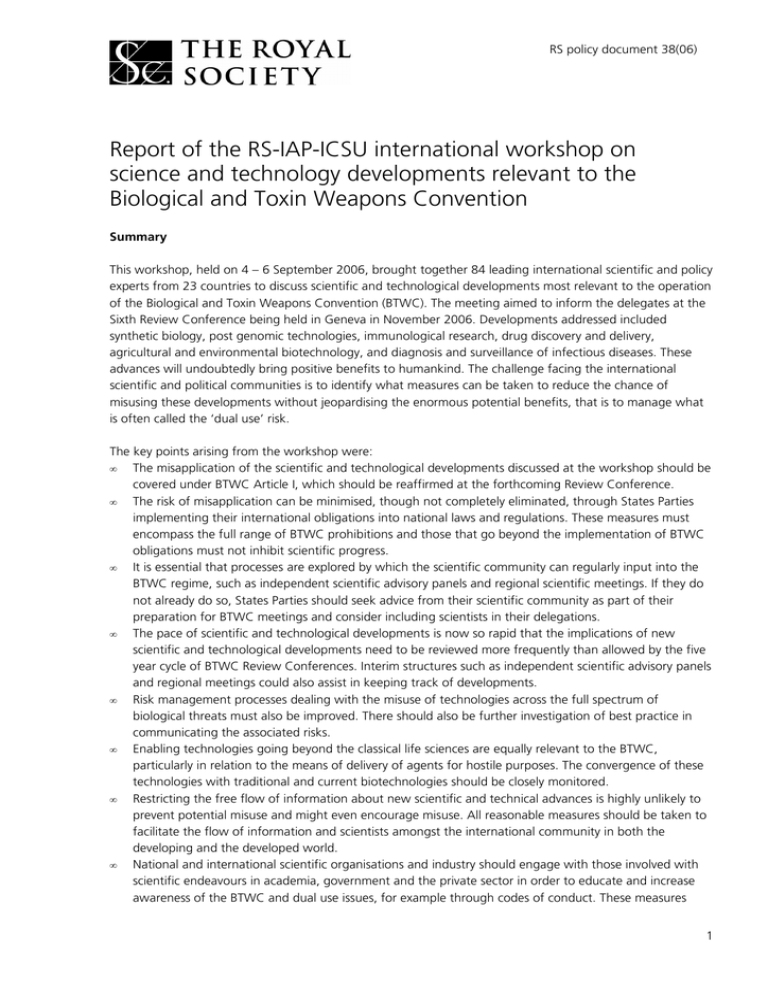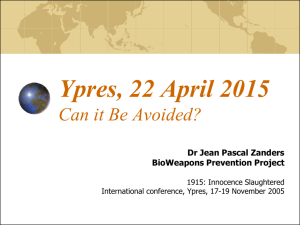Scientific and technological developments relevant to the Biological
advertisement

RSpolicydocument38(06) ReportoftheRS-IAP-ICSUinternationalworkshopon scienceandtechnologydevelopmentsrelevanttothe BiologicalandToxinWeaponsConvention Summary Thisworkshop,heldon4–6September2006,broughttogether84leadinginternationalscientificandpolicy expertsfrom23countriestodiscussscientificandtechnologicaldevelopmentsmostrelevanttotheoperation oftheBiologicalandToxinWeaponsConvention(BTWC).Themeetingaimedtoinformthedelegatesatthe SixthReviewConferencebeingheldinGenevainNovember2006.Developmentsaddressedincluded syntheticbiology,postgenomictechnologies,immunologicalresearch,drugdiscoveryanddelivery, agriculturalandenvironmentalbiotechnology,anddiagnosisandsurveillanceofinfectiousdiseases.These advanceswillundoubtedlybringpositivebenefitstohumankind.Thechallengefacingtheinternational scientificandpoliticalcommunitiesistoidentifywhatmeasurescanbetakentoreducethechanceof misusingthesedevelopmentswithoutjeopardisingtheenormouspotentialbenefits,thatistomanagewhat isoftencalledthe‘dualuse’risk. Thekeypointsarisingfromtheworkshopwere: • Themisapplicationofthescientificandtechnologicaldevelopmentsdiscussedattheworkshopshouldbe coveredunderBTWCArticleI,whichshouldbereaffirmedattheforthcomingReviewConference. • Theriskofmisapplicationcanbeminimised,thoughnotcompletelyeliminated,throughStatesParties implementingtheirinternationalobligationsintonationallawsandregulations.Thesemeasuresmust encompassthefullrangeofBTWCprohibitionsandthosethatgobeyondtheimplementationofBTWC obligationsmustnotinhibitscientificprogress. • Itisessentialthatprocessesareexploredbywhichthescientificcommunitycanregularlyinputintothe BTWCregime,suchasindependentscientificadvisorypanelsandregionalscientificmeetings.Iftheydo notalreadydoso,StatesPartiesshouldseekadvicefromtheirscientificcommunityaspartoftheir preparationforBTWCmeetingsandconsiderincludingscientistsintheirdelegations. • Thepaceofscientificandtechnologicaldevelopmentsisnowsorapidthattheimplicationsofnew scientificandtechnologicaldevelopmentsneedtobereviewedmorefrequentlythanallowedbythefive yearcycleofBTWCReviewConferences.Interimstructuressuchasindependentscientificadvisorypanels andregionalmeetingscouldalsoassistinkeepingtrackofdevelopments. • Riskmanagementprocessesdealingwiththemisuseoftechnologiesacrossthefullspectrumof biologicalthreatsmustalsobeimproved.Thereshouldalsobefurtherinvestigationofbestpracticein communicatingtheassociatedrisks. • EnablingtechnologiesgoingbeyondtheclassicallifesciencesareequallyrelevanttotheBTWC, particularlyinrelationtothemeansofdeliveryofagentsforhostilepurposes.Theconvergenceofthese technologieswithtraditionalandcurrentbiotechnologiesshouldbecloselymonitored. • Restrictingthefreeflowofinformationaboutnewscientificandtechnicaladvancesishighlyunlikelyto preventpotentialmisuseandmightevenencouragemisuse.Allreasonablemeasuresshouldbetakento facilitatetheflowofinformationandscientistsamongsttheinternationalcommunityinboththe developingandthedevelopedworld. • Nationalandinternationalscientificorganisationsandindustryshouldengagewiththoseinvolvedwith scientificendeavoursinacademia,governmentandtheprivatesectorinordertoeducateandincrease awarenessoftheBTWCanddualuseissues,forexamplethroughcodesofconduct.Thesemeasures 1 RSpolicydocument38(06) wouldpromoteindepthimplementationoftheBTWCandhelptofurtherresponsiblestewardshipinthe lifesciencesandtoensurevigilancewhenworkwithdualusepotentialisundertaken. 1 Introduction TheworkshopwasheldattheRoyalSocietyon4–6September2006andwasjointlyhostedbytheRoyal Society,InternationalCouncilforScience(ICSU)andInterAcademyPanelonInternationalIssues(IAP).The followingscientificandtechnologicaldevelopmentsandtheirimplicationsontheBTWCwereaddressed: • syntheticbiology; • postgenomictechnologies; • immunologicalresearch; • drugdiscoveryanddelivery; • agriculturalandenvironmentalbiotechnology; • diagnosisandsurveillanceofinfectiousdiseases. Thisreportoutlinesthedualusedilemmafacingresearchinthelifesciencesandsummarisesthe presentationsmadeattheworkshopontheabovedevelopments,aswellasdiscussionsoftheirassociated dualuserisks.Keyissuesthatemergedarethenpresentedfollowedbytheworkshop’sconclusions.A backgroundsummarytotheBTWC,theworkshopprogrammeandalistofparticipantsarelistedin appendicesA,BandC,respectively.ThepresentationsfromthespeakersarealsoavailableontheRoyal Societywebsite(www.royalsoc.ac.uk/policy)andarereferredtointhisreport. Thisreportrepresentsviewsexpressedattheworkshopanddoesnecessarilyrepresentviewsofthehost organisations. Ourthanksgototheworkshoporganisingcommitteewhoadvisedontheprogrammeoftheworkshopand thecontentsofthereport.ThiscommitteecomprisedofProfessorRoderickFlowerFRS(QueenMary, UniversityofLondon),ProfessorMaryOsborn(MaxPlanckInstitute,Germany),ProfessorSergioJorge Pastrana(CubanAcademyofSciences),Dr.CarthageSmith(InternationalCouncilforScience)andProfessor PieterSteyn(StellenboschUniversity,SouthAfrica).WewouldliketothanktheAlfredPSloanFoundationfor itsgenerousgrantfortheworkshop,aswellastheInterAcademyPanel,InternationalCouncilforScienceand WellcomeTrustfortheirfinancialcontributions.WewouldalsoliketothanktheUSNationalAcademiesstaff forassistingwiththeorganisationoftheworkshop. 2 The BTWC context TheBTWCwillonlyworkproperlyifitevolvesindirectionsthatarescientificallysoundandmakesensein termsofpolitics,sociology,lawandinternationalrelationsinitsmilitaryanddiplomaticdimensions.Care mustbetakentokeeptherightbalanceofincentivesanddisincentivesfavourabletocompliance,and governmentsneedtogiveitmorecontinuousattentionanddemonstratemorevisiblythattheyholditin highesteem.However,thiscareandattentionandhighesteemcannotcomefromgovernmentalonebut mustalsocontinuetocomefromnationalacademiesofscience,internationalscientificunionsandthe relevantprofessionalorganisationsinthelifesciences,aswellasuniversities,researchinstitutesandNGOs andothercivilsocietyorganisations.FurtherdetailsofBTWCobligationsaregiveninAppendixA,aswellas beingoutlinedindetailinthepresentationmadebyMrNicholasSims. TheRoyalSociety S&TdevelopmentsrelevanttotheBTWC|November 2006| 2 3 RSpolicydocument38(06) Dual use dilemmas Itwasstressedthat‘dualuse’relatestothethreatofmisapplyinginformationortechnologiesratherthanthe carryingoutofresearchitself.Thishighlightstheextentofdualusedilemmassincemanytypesofresearch maybedualusebyimplication.However,justbecauseapieceofresearchisconsideredtobedualuse,this doesnotmeanthatitshouldnotbecarriedout.Rather,thisclassificationservestoemphasisethatspecial considerationmaybewarrantedregardinghowtheresearchiscarriedoutandhowitsresultsare communicated. Thishighlightstheproblemofdefiningdualuseinthelifesciences.OnedefinitionisprovidedbytheUS NationalScienceAdvisoryBoardforBiosecurity(NSABB):‘biologicalresearchwhichmayprovideknowledge, products,ortechnologythatcanbedirectly misappliedwithsufficientscope soastothreatenpublichealth orotheraspectsofnationalsecurity,suchasagriculture,plants,animals,theenvironmentandmateriel’ (NSABB2006).Examplesofdualuseresearchincludethe‘experimentsofconcern’highlightedintheUS NationalResearchCouncilreportBiotechnology research in an age of terrorism(USNRC2004).Theseare experimentsthatwould: 1 Demonstratehowtorenderavaccineineffective; 2 Conferresistancetotherapeuticallyusefulantibioticsorantiviralagents; 3 Enhancethevirulenceofapathogenorrenderanon-pathogenvirulent; 4 Increasetransmissibilityofapathogen; 5 Alterthehostrangeofapathogen; 6 Enabletheevasionofdiagnostic/detectionmodalities; 7 Enabletheweaponisationofabiologicalagentortoxin. Participantsstressedtheimportanceofinvolvingthewiderinternationalscientificcommunityinthe formulatingofnewrulesandregulations. 4 Synthetic biology Unlikesystemsbiology,whichanalyseslargequantitiesofdataonthesimultaneousactivityofmanygenes andproteins,syntheticbiologyreducesthesamesystemstotheirsimplestcomponentsbymodellingpatterns ofgeneexpressionasgeneticcircuits.PiecesofDNAaretreatedasfundamentalblackboxmodulesthatcan besplicedtogethertoconstructwhatareeffectivelybiochemicallogicboards.Circuitsareintroducedinto bacteriaandthosethatperformbestareselected.Inthisway,biologicalcircuitsareempiricallyrefinedto arriveatthebestcomputationalsolutions Likeelectroniccircuits,livebacterialcircuitsperformsimplecomputationstofunctionassensorsandinput andoutputdevices.Forexample,researchershaveengineeredbacteriatobesensitivetotheirexternal environmentsothatgivencertainenvironmentalconditionsgenescodingforfluorescentproteinsare activatedandthebacteriaflashorglow.Syntheticbiologythereforehasmanyusefulpotentialapplications, suchasdesigningbacteriatodetectchemicalandbiologicalagentsanddiagnosedisease.Furtherdetails weregiveninthepresentationmadebyProfessorDrewEndy. TheRoyalSociety S&TdevelopmentsrelevanttotheBTWC|November 2006| 3 RSpolicydocument38(06) Syntheticbiologyandattemptstosynthesisesimplebacterialgenomesaredrivingthedevelopmentofbetter waystomakelargerpiecesofDNA.Furthermore,syntheticbiologyhashelpedcatalyseprogressacross biologicalengineeringdisciplinessinceresearchersnolongerneedtheexpertisetoprepareDNArelevantto theirresearchandtherebysavetimeandmoney.Thistechniqueisavailablecommerciallyworldwidesoitis nowsignificantlyeasiertoengineermoregenesonincreasinglylargerscales,especiallysincegeneticmaterial canbeorderedbymailandDNAsynthesiserscanevenbeboughtovertheinternet. 4.1 Dual use risk Syntheticbiologypromisestodeliverextensivebenefitstoprogressinthelifesciencesandhumankind. However,participantsfeltthatthepotentialdualuseriskofsyntheticbiologyishigh.Theeasewithwhich geneticmaterialcanbesynthesiseddeskillstheprocessofbiologicalengineering,andso‘backyardorgarage biology’maysimplybeinevitable.Theconcernisthataneradicatedorextinctbiologicalagentmaybe reconstituted(thepoliovirus,forexample,wasentirelychemicallysynthesisedin2002)orapathogenicagent ortoxincouldbegeneratedoutsideofexistingcontrolledandregulatedframeworks.Onewaytoreducethe riskofmisuseofsyntheticbiologyisthroughincreasedtrainingandawarenessraisingamongstscientists aboutdualuseissuesandrelevantnationalandinternationallawsandregulations.Thisappliesequallyto thoseworkinginacademia,governmentandtheprivatesector. 5 Post genomic technologies 5.1 Genetic targeting and pharmacogenetics TheHumanGenomeProjecthassignificantlyexpandedourknowledgeofgeneticpolymorphisms(DNA sequencesthatvarybetweenmembersofaspecies)someofwhichaffectthesusceptibilityofindividualsto someinfectionsandtherapeuticdrugs.Forexample,geneticvariationhasasignificantroleinthe developmentofAIDS.GeneticanalyseshaverevealedgeneticpolymorphismsregulatingHIV-1cellentryand cytokinedefencestoHIV-1.Manyothergenesandthesystemstheycontrolarestillyettobediscovered.The presentationmadebyProfessorWinstonHidediscussedthisissueingreaterdetail. Geneticpolymorphismsnotonlyexistattheleveloftheindividualbutalsoatthelevelofthegroup.Stable geneticdifferencesandsimilaritiesexistbetweenpopulationgroupsofdifferinggeographicorigin,raceand ethnicity.Forexample,homozygosityforamutationintheCCR5 geneispresentlyconsideredtobethemost relevantgeneticfactorexplainingresistancetotheHIV-1virus,butonlyEuropeansappeartohaveit.Studies havealsohighlightedsignificantgeneticpolymorphismsacrossAfrican,AsianandEuropeanpopulationsfor genefamiliesthatmediatethemetabolismofcertainclinicallyusefuldrugsandenvironmentaltoxins.Even subpopulationsshowgeneticvariationswithsignificantdifferencesbetweenWhiteAmericansandAfrican Americans,andbetweenPortugueseandBlackBrazilians.DrGuilhermeSuarez-Kurtz’spresentationoutlined furtherdetails. Pharmacogeneticsthereforeaimstotargetthesedifferencesandsimilaritiestodesignmoreeffective, personaliseddiagnosesandvaccines.However,thissortofresearchhasonlybeenpossibleduetopowerful computationaltechniquesofbioinformatics,whichcanextractbiologicalinformationthatwouldhave previouslybeenlostasbackgroundcellularnoise(RoyalSociety2005a).Atthescientificlevel,previously difficultandintractableproblemscannowbetackledandsolvedinradicallyshortertimes;andclinicallythese TheRoyalSociety S&TdevelopmentsrelevanttotheBTWC|November 2006| 4 RSpolicydocument38(06) newinformationtechniqueshavegivenrisetouserfriendlydiagnostictechnologiesthatproviderapid genomicanalysesofindividuals. Bioinformaticshasalsoenabledtheglobalmanagementofbiologicalinformation.Thereisavastrepository ofpublicdomainsoftwareforcomputationalbiology,andindividualaccountsforremoteaccessanddata processingcanbeopenedathigh-performancecomputerfacilitiesandbioinformaticsregionalcentres, includingFIOCRUZinBrazil,SANBIinSouthAfrica,CeCalCULAinVenezuela,andICGEBinItalyandIndia.In thisway,digitallibrariesofbiologicalresearchresultsallowtheglobalsharingofknowledge.Biological researchcanbedistributedovermultiplelaboratoriessoinvestigatorscanworkcollaborativelyaroundthe world. Bioinformaticsalsorequiresrelativelymodesthardwareandtechnicalsupport,whichhelpsexplaininpartthe rapidriseofbiotechnologyinAfrica.LINUXoperatingsystems,forexample,permittheuseofpersonal computersaspowerfulworkstations,andinformationtechnologytrainingforAfricanscientistshasbeen availableonline,althoughthishasbeenconstrainedbylimitedinternetconnectivity. 5.2 Proteomics Theaimofproteomicsistounderstandtheexpressionandmodificationofproteinsandtheirinvolvementin metabolicpathwaysinrealtimeinasingle(orsetof)cell(s).Thishasonlybeenpossibleduetoadvancesin thespeed,automationandavailabilityofbasictechniques.Forexample,newarraytechnologiesand advancesinmassspectrometryprovideimprovedresolutionofproteinspecies,whilstfluorescentprobes, coatednanoparticlesandRamanandfluorescentopticalspectroscopiescanmonitorintracellularsignalsmore effectively.Onevaluableapplicationofproteomicshasbeenthemanufactureofsensitivebiosensorsto diagnosecertainillnessesinindividuals.ThepresentationmadebyDrAndrewPittoutlinedfurtherdetails. However,amajorchallengehasbeenthatseeminglysimplepathwaysareinfactembeddedinextremely complexintra-andintercellularnetworks.Consequently,thereisagrowingawarenessoftheusefulnessof systemsbiologyanditspowerfulcomputationaltechniquestoanalyseandintegratethecomplexinteractions ofindividualmolecularelementsofbiologicalsystemsintomanageable,predictivemodels.Forexample,itis nowpossibletolookattheeffectofaparticularstimulusonmanydifferentsignaltransductionpathways thatcontrolcellularresponsestoinfection,andthishashelpedadvancetheunderstandingofpathogenesis, virusmorphologyanddrugresistanceinmicro-organisms,aswellasmechanismsofdiseaseandrelated cellularbiochemistryinhumans. 5.3 Transcriptomes and metagenomics Whereasmuchofacell’sDNAdoesnotcodeforproteins,acell’stranscriptome(whichreferstoall messengerRNAmoleculesortranscriptsproducedinthatcell)reflectsalltheproteincodinggenesthatare beingactivelyexpressedatanygiventimeinacell.Transcriptomeanalysesarethereforevaluable contributionstounderstandingtranscriptionalregulation,andhavebeenusedtoinvestigatehowcancercells progressandhowstemcellsmaintaintheiruniqueproperties. Onenewpost-genomictechniquethathasfacilitatedtheseanalysesispairedendditagging(oftenknownas PET),whichhassignificantlyimprovedtheefficiencyofDNAsequencing.Thistechnologyhasalsobeenused inmetagenomeanalysis,whichidentifiesandstudiesgenomesrecoveredfromenvironmentalsamplesrather thanfromclonalcultures.Thisareaofresearchhasreceivedattentionespeciallygivenrecentpublichealth TheRoyalSociety S&TdevelopmentsrelevanttotheBTWC|November 2006| 5 RSpolicydocument38(06) concernsoverSARSandavianflu.Oneaimhasbeentodiscoverpreviouslyuncharacterisedvirusesthatare relevanttohumanhealth.Forexample,onesetofstudiescarriedoutinSingaporeinvestigatedmicrobial communitiesfoundinhuman-associatedenvironments.Unexpectedly,manyofthemicrobialcommunities takenfromindoorairsampleswereofhumanorigin,andcertaingeneswerefoundtobeenrichedinsome oftheairmicrobes,includinggenesinvolvedinresistancetodesiccationandoxidativestress,andpossible virulencefactors.DrYijunRuanoutlinedfurtherdetailsinhispresentation. 5.4 Dual use risk Giventhecontinuedpresenceofethnictensionsandconflictsintheworldtoday,thefearisthatgenetic polymorphismscouldbeusedtotargetspecificpopulationsfornon-therapeuticpurposes.Someparticipants feltthatthisfearwasexaggeratedbecauseinter-ethnic,andtherebygenetic,admixtureisbecoming commonorincreasingatafastpace,andsoitisrarethatagivenpolymorphismisspecifictoonepopulation. Moreover,althoughtherearealargenumberofpolymorphismswithinthehumangenome,theproportion ofthemlyinginfunctionallyimportantareasissmallandthereforereducestheriskofselectivetargeting. Othersarguedthattargetingneednotbehugelyeffectiveorcompletelyselective.Publicperceptionofthe riskposedbybioterrorismfeedsintothegeopoliticalresponsetoincidents,andsoevenamoderatelevelof selectivitywouldbesufficientforseriouslydamagingsocietalstructures.Thesocialpanicresultingfromthe attackwouldbeenoughtotriggereffectsfarinexcessofthosefromtheinitialattackitself. However,targetingneednotinvolveindividualpolymorphisms.Forexample,certaincellsurfaceantigens havedistinctivedistributionsthatvarywithgeographicoriginandsovirusescouldbeusedtotargetdistinct ethnicgroupswithcharacteristiccellsurfacemoleculeswithoutneedingtoidentifypopulation-specific geneticvariations(InstituteofMedicineandNationalResearchCouncil2005). Inaddition,genomicmedicinepresupposesasoundunderstandingoftherelationshipbetweengenetic differencesandpathogens’mechanismofdisease.Forexample,researchershaveinvestigatedhowgenesin thebacteriaMycobacterium tuberculosisandVibrio choleracontroltheinvasionofthebacteriaintohost environments.Indoingso,potentialdrugtargetshavebeenidentified,aswellasnovelvirulencefactors. ProfessorWinstonHidediscussedfurtherdetailsinhispresentation.Theconcernisthatthisknowledgecould bemisusedtoenhancethesusceptibilityofhostpopulationstopathogeninfection. Similarly,someparticipantsfeltthatknowledgeofthediagnosticapplicationsofpost-genomictechnologies couldbemisusedtoenablebiologicalagentsortoxinsevadedetectionmethodologies.Othersalsoraised concernsthattheproblem-solvingpromiseofsystemsbiologycouldbemisusedtoidentifywaysto deliberatelymanipulatebiologicalsystemswiththeintenttodoharm. 6 Immunological research 6.1 Manipulating innate immunity ‘Innateimmunity’representsthefirstlineofnon-specificdefenceagainstpathogensandisessentialfor keepinganinfectionincheckbeforelongerlasting,specific‘acquiredimmunity’canbeinduced.Cellsofthe innateimmunesystemrespondtopathogenassociatedmolecularpatterns(PAMPs)onalienmicrobesand producecytokines,whichinmoderateamountscontributetodefenceprocessesbutwhenoverproducedcan TheRoyalSociety S&TdevelopmentsrelevanttotheBTWC|November 2006| 6 RSpolicydocument38(06) leadtoautoimmunityandevendeath.Theseverereactionssufferedbyvolunteersduringclinicaldrugtrials atNorthwickParkHospitalinLondoninspring2006highlightedthedisastrousclinicaleffectsofagentsthat induceacytokinestorm. Severalrecentreportsinthescientificliteraturedescribethepossibilitiesoftargetingtheinnateimmune systemfortherapeuticpurposes,especiallyusingPAMPswhetherinnaturalformorartificiallydesigned.For example,syntheticimidazolequinolonestargetinnateimmunesystemreceptorsforthetreatmentofgenital wartsandotherdiseasescausedbyhumanpapillomaviruses;andsyntheticoligodeoxynucleotidescanprovide genericimmunityinrodentsagainstmanydifferentbacteria,virusesandparasites.Thepresentationmadeby ProfessorKathrynNixdorffgavefurtherdetails. 6.2 Manipulating acquired immunity ShortinterferingRNA(siRNA)orsilencingRNAreferstoaclassofsmallRNAmoleculesthatcanactuponand interruptRNArelatedpathways,mostnotablythosecontrollinggeneexpression.Forexample,the introductionofsiRNAcomplexescansilencegeneexpressioninmammaliancellswithouttriggeringaninnate immuneresponse.Thishasbeenimportantforcancertreatmentswhereimmunitycanbeboostedby silencingimmunesuppressivegenes.Conversely,immuneresponsivegenescanbesilencedtolower immunity,whichisusefultotreatallergicandautoimmunediseases,aswellasgraftrejectionafter transplants.Inaddition,siRNAmethodsarebeneficialbecausetheycaninhibitspecificgenesthathavebeen inaccessibletoconventionaldrugs.DrWei-PingMindiscussedtheapplicationsofsiRNAinhispresentation. 6.3 Dual use risk Theconcernisthatimmunityortheeffectivenessofimmunisationcouldbedisruptedfornon-therapeutic purposes.Aworstcasescenariowouldinvolvedesigningatooltointerferewiththesignallingmechanisms withinimmunesystemstomanipulateeithertheinnateoracquiredimmunesystems.Ontheonehand, cytokineproductioncouldbeoverstimulatedasabiologicalweapon.Ontheotherhand,over-silencing immuneresponsivegenestoomuchcouldproduceahypo-immuneresponse,leadingtothedevelopmentof cancer;whilstover-silencingimmunesuppressivegenescouldtriggerahyper-immuneresponse,leadingto autoimmunedisease.Manipulatingtheinnatesystemisconsideredtobethemoredangerousofthetwo becauseasanon-specificmechanismitwouldhavemorewidespreadeffects. Theimmunesystemdoesnotactinisolationbutinteractswithothersystemsandbioregulators,suchasthe nervousandendocrinesystems.Consequently,thedualuseriskisraisedtoawholeneworderofcomplexity. Byaffectingthefunctionsoftheseothersystems,evensmallmanipulationstotheimmunesystemcouldbe amplifiedtobringaboutdevastatingconsequences. Onthewhole,participantsagreedthatimmunologicalresearchdoesposeadualuseriskbuttheyfeltthat thispotentialriskshouldnotbeexaggerated,especiallysincecurrentdeliverysystemsdonotalloweffective targetingofhumanoranimalimmunesystems. TheRoyalSociety S&TdevelopmentsrelevanttotheBTWC|November 2006| 7 7 7.1 RSpolicydocument38(06) Drug delivery Gene therapy and vectorology Nucleicacids,suchasDNA,canbedeliveredintocells,afterwhichtheyaredecodedandtranslatedinto therapeuticallyusefulproteins.Thisallowscellstobetargetedwhilstavoidingsomeofthetoxicsideeffects causedbyconventionaldrugs.Therehasbeenconsiderableresearchinto‘artificialviruses’-polymerbased complexescontainingDNAwithspecialmolecularfeaturestoenhancetheefficiencyofDNAuptakeinto specificcells.Thistechniquehasbeenusedincancertreatment,forexample,whereDNAisreleasedwithin cancercellsandtranslatedintoproteinsthatcankilltumourcellsdirectly,blockthecellcycleorstimulate anti-tumourimmunity.Inonestudy,localapplicationsofsyntheticdoublestrandedRNAondifferent tumoursinmiceledtotheeradicationofintracranialglioblastoma;andDNAcodingforcytochromeP450 isoformsdirectedattumourcellsactivatedcyclophosphamide,whichhelpsboostacquiredimmunityagainst cancerouscells.DrManfredOgrisoutlinedfurtherdetailsinhispresentation. 7.2 Dual use risk Thisareaofresearchisalreadygeneratingbenefits.However,participantsfeltthatitspotentialdualuserisk ishighbecausethefeasibilityofdeliveryiscentraltothetargetingofgenesandbiologicalsystems(whether fortherapeuticornon-therapeuticpurposes).Theconcernisthatvectorologicalresearchcouldbeusedto deliverharmfulgenesintohostcellsandincreasethestability,transmissibilityorabilitytodisseminate harmfulbiologicalagentsortoxins.Whiledeliveryiscurrentlyproblematic,researchisbeingcarriedoutto improvedelivery,exploitingnanotechnologytoenhanceabsorptionofaerosolsandliposomeandlipid nanoparticleformulationsofchemicallymodifiedandstabilisedsiRNAcomplexes(RoyalSociety-Royal AcademyofEngineering2004). 8 Agricultural and environmental biotechnology 8.1 Biopharming Theagriculturalapplicationsofbiotechnologyarevariedandhavehelpedfarmersgrowcropswithlarger yieldsthataremorerobustinthefaceofdiseaseanddrought,aswellascropswithimprovednutritional contentandgreaterphotosyntheticefficiency.Cropshavealsobeengeneticallymodifiedtoproduceand delivervaccinesandengineeredplantscanelicitanimmuneresponseinhumans.Forexample,clinicaltrials onhumansarecurrentlyunderwaytotestvaccineproducedinediblecrops. 8.2 Pest control Onenewapplicationofbiotechnologyconcernsnon-chemicalcontrolsoninsectpestinfestations,which causegreatlossesespeciallyindevelopingcountrieswithagriculturallydependenteconomies.InTanzania, forexample,maizeisastaplefoodandamajorcashcrop.Tanzaniahastraditionallyreliedontheuseof persistent,non-specificchemicalpesticidestocombatpestoutbreaks.However,thishasledtogreat environmentaldamageincludingcontaminationduetoresidualpoisons,buildupoftoxinsinfoodchainsand thekillingofbeneficialorganisms.Thesehaveallbeencompoundedbythespreadofresistanceinpest populations.Moreover,chemicalpesticidesinAfricaareoftenveryexpensive,especiallywhenthese associatedrisksandsocialcostsareincluded. TheRoyalSociety S&TdevelopmentsrelevanttotheBTWC|November 2006| 8 RSpolicydocument38(06) Tocombattheseproblems,Tanzaniahastriedtodiversifyitsinsectpestmanagement,especiallythrough biologicalcontrols,suchasintroducingnaturally-occurringpest-specificpredatorsandparasites.Programmes ofsterilisingmaleshavealsobeentried,aswellaspheromoneusetocontrolsexualbehaviour.Researchers havealsogeneticallyengineeredcropstobepestresistant,andinvestigatedtheecologyofpeststolookat waystointerruptpestdevelopmentandreproduction.DrCostanciaRugumamudiscussedintegratedpest managementinfurtherdetailinherpresentation. 8.3 Environmental biotechnology Biotechnologyapplicationsalsoextendoutsideofthefarm.InPakistan,forexample,theCentrefor MolecularGeneticsattheUniversityofKarachihasisolatedbacteriafromindigenoussourcesanddeveloped themforlargescaleindustrialandmedicalapplications.Bacteriahavebeenusedtofilteranddigesttoxic aromatics,suchaspesticidesandcrudeoilcomponents,andcertainoileatingbacteriahaveevenbeen successfullyusedtodecontaminatebeachsandafteroilspills.Bacteriahavealsobeenusedtoproducebiofertilizersandbiodegradableplastics,whichhavebeenusefulforsafelydestroyingsurgicalequipmentand babyandfemalehygieneproducts.DrNuzhatAhmadgavefurtherdetailsinherpresentation. 8.4 Therapeutics and vaccines Onepromisingsecurityapplicationofbiotechnologyiscreatingstrategicstockpilesoftherapeuticsand vaccinesagainstbiologicalagents.In2004,ProjectBioshieldwaslaunchedintheUSAwitha$5.6billion budget(tospendby2014)onstrategicreservesoftherapeuticsandvaccinesagainstknownbiologicalagents tobestoredastheStrategicNationalStockpile(MacKenzie2006).However,strainscaneasilymutateand becomeresistanttostockpiledvaccines;longtermreservesoftherapeuticstendtobeunstable;andlarge scalemanufacturingoftherapeuticstakesonetothreeyearsusingtraditionaltechniques. Alternativegeneticengineeringtechniquesarebeingexploredtoavoidtheseproblems.Onetechnique involvestransientgeneexpressioninplantswheregenescodingforrelevantproteinantigensareinserted intoaplantvirus,whichisthenintroducedintoplanthosts.Replicationofthevirusthenleadstothe productionoftheproteinantigens,whichcanthenbeharvested.AnothermethodistoconvertviralRNA intoaDNAsequence,insertthisintoadeliveryvectorandthenintroducethevectorintoaplant.Witheach replicationtheRNAexpressedfromtheDNAleadstotheproductionoftheantigen.Similarly,researchhas beencarriedouttoproducecountermeasuresagainstorganophosphatenerveagents,suchassarin. Organophosphatetoxicityoccursbyinhibitingtheneurotransmitterbreakdownbyacetylcholinesterase (AChE),andsoplantshavebeenengineeredtobio-manufacturehumanAChEthatcanbeusedasa molecularspongetomopupnervegasagentsandhencedecreasetheirtoxicity. Themajorappealofthistechnologyisthatplantmanufacturingfacilitiesarecheapandcanbeeasilyand rapidlyscaleduptoproducelargequantitiesofvaccines.USArmyresearchonproducingplaguevaccines fromplantsfoundthat100plantscouldyieldagramofpurifiedvaccine,theequivalentof75,000doses,and timefromtheinitialinfection(ofthevectorintotheplants)untilharvesttookonly12days.ProfessorCharles Arntzenoutlinedfurtherdetailsinhispresentation.Theproteinantigensproducedwerethenpurifiedfor deliverybyinjection.Thismeansthathighlyeffectivevaccinescanbeproducedinacost-effectivemannerfor countrieswishingtocreateondemandstrategicstockpilesofthreatreductionagents. TheRoyalSociety S&TdevelopmentsrelevanttotheBTWC|November 2006| 9 RSpolicydocument38(06) 8.5 Dual use risk Participantsfeltthatthedualuseriskofthisareaofbiotechnologyislow.However,itwasnotedthat transgenicplantscouldbemalevolentlyengineeredtomassproducelargequantitiesofnon-therapeutic (toxic)proteins.Concernswerealsoraisedthattargetingcropproductioncouldhavebroaderramifications sincebyenteringthehumanfoodchainbiologicalagentsandtoxinscouldbeeasilydeliveredacrosslarge populations. 9 Diagnosis and surveillance of infectious diseases Thereislittledifferencebetweenpreparingfor,andrespondingto,abioterroristattackandanatural outbreakofdisease.Bothcaseswillrequirethesamesortofdiagnosticandsurveillanceinfrastructure. However,giventheirdifferentsocio-politicalconsequences,itisvitalthatabioterroristattackisnot misinterpretedasanaturaloutbreakofdisease,andvice versa. Determiningwhetherabioterroristeventhastakenplacewillbedifficult.Clinicalsignsmaynotappearfor daysorweeksandinitialsymptomsmaybenon-specific.Likelyindicatorswillincludelargenumbersof causalitieswithunusualepidemiologiesand/ormultiplesimultaneousoutbreaksofmulti-drugresistant pathogens.Guides,suchasCategoryA,BandClistsfromtheUSCentersforDiseaseControlandPrevention (CDC)website,areavailabletoidentifykeydiseases(CDC2006).Oneproblemisthatthesedonotinclude non-indigenousdiseases.However,giventhescaleoftoday'sinternationaltradeandtravel,diseaseshave spreadacrosstheworldandsonon-indigenousdiseasesshouldnotbeoverlooked,especiallyincasesof unusualsymptomology.Itisalsoimportantthatknowledgeaboutdiseasesthataresupposedlyextinct,such assmallpox,isnotlostasthiswouldbevitalforearlydiagnosisandresponseifthediseasewastoreappear. Theactivitiesandresponsesofthehealthservicesandintelligenceandlawenforcementagenciesmustalso beco-ordinated.Healthandsecurityservicesneedtoagreeonwhatmustbemonitoredandontheuseof surveillanceguidelines,includinginstructionsonthedetectionofevents,andthecollectionofappropriate laboratoryspecimensforforensicevidence.Therealsohastobeasuitablelaboratoryservicewithahierarchy ofcompetencetoconductvarioustypesofinvestigationdependingontheperceivedlevelofbiohazard. 9.1 Dual use risk Someparticipantsfeltthatbioterrorismhadgeneratedconsiderablepoliticalinterest,disproportionatetothe importanceoftheevents,andthatnaturaloutbreaksofdiseases(suchasSARSandavianflu)aremuchmore likelytooccurthanbioterroristattacks.Lossoflifehasbeenfargreaterfromnaturaldiseasesthanfrom bioterroristattacks.Forexample,ithasbeensuggestedthatthegeopoliticalimpactfromtheUSanthrax lettersinautumn2001,whichresultedin22casesandfivedeaths,wasofasimilarscaletothe2002-2003 SARSoutbreak,whichcausedanestimated8098casesand774deaths(RoyalSociety-WellcomeTrust2004). Otherparticipantsfromdevelopingcountriesstressedtheenormouslossoflifecausedbynaturally-occurring diseases,suchasAIDS,malariaandtuberculosis,andsuggestedthatbioterroristthreatsshouldbeviewedin thiscontext.Evenso,establishingandmaintainingnationalandglobalsurveillancesystemsforhuman, animalandplantdiseaseisakeyelementofthedefenceagainstthemisuseofscientificandtechnological developments. TheRoyalSociety S&TdevelopmentsrelevanttotheBTWC|November 2006| 10 RSpolicydocument38(06) Onemajorchallengeisthateffectivemedicalsurveillanceinfrastructuresonlyexistinthemostwelldeveloped countrieswherediagnosismaytakeonlyafewhourswhereasinlessdevelopedcountriesitmaytakeseveral weeks.Thissignificantlydecreasestheefficiencyofrespondingtoanoutbreakofinfectiousdiseaseora bioterroristattack.Giventheincreaseinglobaltravel,whichhasincreasedthespreadofdiseaseacrossthe world,nocountrycanaffordtoactinisolation.Theacquisitionofthenecessaryinfrastructure, communicationsandskillsformonitoringinfectiousdiseasesinlessdevelopedcountriesshouldthereforebe ofparamountconcernforallcountries.StatesPartiesshouldcooperatewitheachotherandinternational organisations(suchasWorldHealthOrganisation,WorldOrganisationforAnimalHealthandUnitedNations Food&AgriculturalOrganisation)tofurtherthedevelopmentandapplicationofscientificdiscoveriesforthe detection,preventionandcounteringofdisease,underArticleXoftheBTWC(JointScienceAcademies 2006). 10 Key issues 10.1 Strengthening scientific input into the BTWC ParticipantsstressedtheimportanceoftheuniversalapplicationoftheBTWC.TheBTWCunequivocally coversallnaturallyorartificiallycreatedoralteredmicrobialorotherbiologicalagentsortoxins,aswellas theircomponents,whatevertheiroriginormethodofproduction,thathavenojustificationforprophylactic, protectiveorotherpeacefulpurposes.ParticipantsagreedthatStatesPartiestotheBTWCshouldreaffirm thatthemisapplicationofthescientificandtechnologicaldevelopmentsdiscussedattheworkshopiscovered underBTWCArticleI. ParticipantsalsoemphasisedStatesParties’obligationsunderBWTCArticleIVto‘prohibitandprevent’the development,production,stockpiling,acquisition,orretentionofbiologicaltoxinsandweapons,andto translatetheirinternationalobligationsintonationallawsandregulationsofenforcement.However,this raisesthreemajorchallengestoensure: • nationallegislationandregulationsofenforcementencompassthefullrangeofBTWCprohibitionswhilst makingscientificsense; • measuresthatgobeyondtheimplementationofBTWCobligationsdonotinhibitscientificprogress; • implementationofBTWCobligationsintonationallegislationissensitivetotheparticularpoliticaland scientificcontextofindividualcountries. ThescientificcommunitycanassistinaddressingthesechallengesbyregularlyinputtingintotheBTWC regime.Forexample,thiscouldbeachievedthroughinterimstructuressuchasindependentscientific advisorypanelsandregionalscientificmeetings.Iftheydonotalreadydoso,StatesPartiesshouldalsoseek advicefromtheirscientificcommunityaspartoftheirpreparationforBTWCmeetingsandconsiderincluding scientistsintheirdelegations.Thepaceoftechnologicaldevelopmentisnowsorapidthattheimplications needtobereviewedmorefrequentlythanallowedbythefiveyearcycleofBTWCReviewConferences. Participantssuggestedthatinterimstructuressuchasindependentscientificadvisorypanelsandregional meetingscouldalsoassistinkeepingtrackofdevelopments. Scientificpractices,infrastructurecapacitiesandthepoliticalwilltoenactnationalBTWCrelatedlegislation andregulationvarybetweencountries.Consequently,nationalacademiesofscience,professionalsocieties, universitiesandresearchinstitutes,NGOsandothercivilsocietyorganisationscanallplayaroleintheirown countriesbypromotingtheimportanceoftheBTWCtoensurethattheirgovernmentsfulfiltheirBTWC TheRoyalSociety S&TdevelopmentsrelevanttotheBTWC|November 2006| 11 RSpolicydocument38(06) obligations.Thissortofnationalinputisparticularlyimportanttopromotescientificprogressindeveloping countriessince,assomeparticipantsnoted,thereisaperceptionthatBTWCrelatedlegislationand regulationcouldbeusedbythedevelopedworldtoinhibitscientificprogressindevelopingcountries. ConcernswerealsoraisedthattheBTWCbindsandrefersonlytostatesratherthanindividuals,andthis mightbeunderminedbytheexistenceofterroristgroups.AlthoughtheBTWCwasnotprimarilyintendedas acounter-terrorismdevice,acloserreadingofthetextshowsthatstates’obligationstopreventandprohibit misuseontheirownterritorymakesthemresponsibleinthisrespect.Moreover,thisaspectofpreventionand prohibitionisreinforcedbyotherinternationalmeasuresagainstbothstateactors,suchastheChemical WeaponsConvention,andnon-stateactorsatthenationallevel,suchasUNSecurityCouncilResolution 1540onthenon-proliferationofweaponsofmassdestruction. 10.2 Improved risk management Itwaswidelyagreedthatdualuseresearchinthelifesciencesposesapotentialsecurityrisk.However,the complexityofbiologicalsystemscontinuestomakeitextremelychallengingtounderstandfullyormanipulate them.Itisalsodifficulttopredictthedetailsandapplicationofbreakthroughsgiventheserendipitousnature ofscientificresearch;anditisbecomingincreasinglydifficulttoknowwheretechnologicalbreakthroughswill occurintheworldasmanycountrieshavesophisticatedresearchfacilities.Furthermore,technological developmentsarenowalsobringingprocessesthatcouldfeasiblybeusedtomakeanddeploybiologicaland toxinweaponswithinthecapabilityofsmallgroupsbelowstatelevelbecauseofthereductionincostsand expertiserequired. Participantsagreedthatalthoughmisusecanbeminimised,itcannotbecompletelyeliminated;however,the scopeandimmediacyoftheriskofmisusemustnotbeexaggerated.Sensiblepoliciesmustbeguidedby criticalandrealisticriskassessments.Therefore,riskmanagementprocessestodealwithdualuse technologiesneedtobeimproved.Methodsareneededforundertakingassessmentsacrossthefullspectrum ofbiologicalthreats,rangingfromthedeliberateweaponisationofbiologicalagentsthroughtheinadvertent misuseoftechnologiestoemergingnaturally-occurringdiseases,andthereshouldalsobefurther investigationofbestpracticeincommunicatingtheassociatedrisks.Riskmanagementprocesseswould requirecloseinteractionwithscientistsworkingattheforefrontofdualusetechnologies,whoarebetter equippedtopredictandmitigatesciencebasedsecurityrisks. Inaddition,researchinthelifesciencesshouldnotbeconsideredinisolationfromotherscientificdisciplines becausethedevelopmentandweaponisationofbiologicalagentscaninvolvetechniquesfromfieldssuchas mathematics,engineering,physicsandcomputerscience. Amajorchallengeishowtofactorintheperceptionofriskintodualuseriskanalysis,particularlybythe public.Thisismademorecomplicatedsinceriskenvironmentsandriskperceptionsdifferaroundtheworld andthelikelihoodofabuseinthelifesciencesandtheharmtopublichealthmayvaryaccordingtothe perceptionoftherisksandindividualcountries’effortstoreducethem.Participantsfeltthatasharedrisk methodologyandterminologywouldbeparticularlyusefultounderstandhowcountriesperceivebiosecurity threatsdifferently.Forexample,anumberoflanguages,suchasRussian,SpanishandSwedish,useasingle wordtomeanboth‘biosafety’and‘biosecurity’. TheRoyalSociety S&TdevelopmentsrelevanttotheBTWC|November 2006| 12 RSpolicydocument38(06) 10.3 Openness and transparency Throughouttheworkshopitwasstressedhowopencommunicationhasbeenintrinsictothescientific tradition,providingaforumforvalidating,repudiatingandbuildinguponscientificideasnecessaryfor intellectualandtechnologicalprogress.Someparticipantsfromdevelopingcountrieswereespecially concernedaboutcensorshipsinceaccesstotraining,technologyandtheresultsofresearchcarriedout elsewhereindevelopedcountriesisnecessarytofurtherthedevelopmentofscientificcapacitiesintheir countries(JointScienceAcademies2005).ParticipantsthereforestressedtheimportanceofBTWCArticleX, whichpromotesinternationalcooperationinbiologyforpreventionofdiseaseincludingthefreeflowof informationandscientistsinboththedevelopinganddevelopedworld. Althoughapieceofresearchmaybeconsideredtobedualuse,publicationcanstillbepossible.Forexample, theAmericanSocietyforMicrobiology(ASM)introducedformalprocessesaspartofthepeerreview processforitselevenjournalsformanuscriptsdealingprimarily,butnotexclusively,withresearch conductedonselectagents.In2002,313selectagentsmanuscriptsreceivedspecialscreeningfroma totalof13,929manuscriptssubmitted.Onlytwoofthemanuscriptsreceivingspecialscreeningwere senttothefullASMpublicationsboardforfurtherscreening.BetweenJanuaryandJuly2003of the8557manuscriptssubmittedonly262selectagentsmanuscriptswerescreenedandnonewas referredtothepublicationsboardforfurtherreview(RoyalSociety2005b). Classifyingresearchasdualuseservestoemphasisethatspecialconsiderationmaybewarrantedregarding howitsresultsarecommunicated.Thereareasetofcommunicationoptions,rangingfromfulland immediatepublication,todelayedand/ormodifiedpublicationtorestrictedornopublicationatall.These optionscouldbeusedsinglyorincombinationonacasebycasebasis.Inveryrarecasesconsiderationcould begiventodelayingpublicationofhighlysensitiveinformation,orreleasingonlysomeoftheinformation intothepublicdomain.However,inthesecasestherewouldneedtobeaveryclearbenefitindelaying publication. Censoringresearchwouldnotnecessarilypreventmisuse.Informationislikelytobepublishedelsewhere suchasinotherjournals,websitesorconferenceproceedings,orcommunicatedinformallyviae-mail, telephoneorface-to-facediscussion.Publishingalsomakesothersawareofunintendedresults.Forexample, thepublicationofthepaperontheinsertionoftheinterleukin-4geneintomousepoxmadealargenumber ofresearchersawareofthediscoverythattheinsertionofthisgeneenabledthevirustoovercomeboth geneticresistanceandimmunisationagainstthedisease(RoyalSociety–WellcomeTrust2004).Acommon opinionattheworkshopwasthatcensoringtheresultsofdualuseresearchinordertopreventbioterrorist activitymayinfactbecounter-productive.Censorshipwouldsimplysuffocatenewresearchinthelife sciencesyetwithgreaterscientificexpertise,includingknowledgeofitsharmfulapplications,itwouldbe easiertoprepareforandcombatbioterrorismmosteffectively. Participantsalsohighlightedthatdualuseconcernsarenotlimitedtothescientificcommunityandits academicjournalsbutalsothegeneralpublicandmedia.Publicconfidenceandtrustinthescientific communitycannotbeignored,andthemedianeedstobeencouragedtoreportdualuseaspectsofscience andtechnologyresponsibly.Thisiscrucialsince,asmentionedabove,amajorissueistheperceptionof biosecurityrisks,whichisdeterminedbythelevelofpublicconfidenceandtrustinscience.Themedia thereforeneedseducatingontheseissuesasmuchasscientiststhemselves. TheRoyalSociety S&TdevelopmentsrelevanttotheBTWC|November 2006| 13 RSpolicydocument38(06) 10.4 Education and training Itisessentialtocontinuetoraiseawarenessofdualuseissueswithinthescientificcommunity,including scientistsworkinginacademia,governmentandtheprivatesector,andtherebyhelpresponsiblestewardship tobefurtheredinthelifesciences.Academicandindustrialresearchers,aswellasuniversitystudentsshould beeducatedonthematter,perhapsbyundertakingcoursesinethicsandresponsibleresearchpractice,and shouldbetaughtaboutrelevantinternationallawobligationsoftheirgovernments,especiallyrelatingtothe BTWC.Bioethicscurriculashouldbuildonlocalvaluesandethicalnorms.Someparticipantssuggestedpost14yearoldsshouldalsobetaughtabouttheseissuesatschool. Manyparticipantssupportedtheuseofcodesofconductasavaluableeducationaltool.However,codesof conductarealsousefultoolstolowertherisksassociatedwithusingortransferringsensitiveknowledge. Manyparticipantswereparticularlyconcernedaboutthepossibilityof‘backyard’or‘garage’biologybyboth stateandnon-stateactors;andsomefeltthatcodesofconductcanplayakeyroleindevelopingastrong scientificcultureofresponsiblestewardship. Thepresenceandlevelofcodesofconductandsafetyregulationvariesbetweencountries.Accordingly,ifan internationalscientificcultureofresponsiblestewardshipistobefurtheredinthelifesciences,thereneedto beinternationalstrategiestoharmonise,andtherebyraise,thestandardofnationalregulationandto promoteadherencetocodesofconduct.Oneexampleisthestatementonbiosecurityreleasedbythe InterAcademyPanel,whichwassignedby69nationalacademiesofscience(InterAcademyPanelon InternationalIssues2005).Thestatementhighlightedfundamentalguidingprinciplesfortheformulatingof codesofconductinordertominimisethepossibilityofthemisuseofscientificresearch. Someparticipantsfeltthatsimplyreaffirmingcodesofconductdoesnotprovideanyfurtherilluminationover importantdetailsoftheirscopeandmeaning.Therestillneedtobemoreeffortstoengagewithscientists directlytoeducatethemaboutdualuseissuesandthevalueofcodesofconduct,andencouragethemto inputintotheformulatingofthesecodes.Inthisway,misperceptionswithinthescientificcommunitythat codesofconductarejustanotherlevelofregulationtointerferewiththeirresearchcanbeovercome.Work hasbeencarriedinthisareabysetsofseminarsandworkshops(Dando,Rappert&Chevalier2006). 11 Conclusions 11.1 Strengthening scientific input into the BTWC • TheBTWCunequivocallycoversallnaturallyorartificiallycreatedoralteredmicrobialorotherbiological agentsortoxins,aswellastheircomponents,whatevertheiroriginormethodofproduction,thathave nojustificationforprophylactic,protectiveorotherpeacefulpurposes.ParticipantsagreedthatStates PartiestotheBTWCshouldreaffirmthatthemisapplicationofthenewscientificandtechnological developmentsdiscussedattheworkshoparecoveredunderBTWCArticleI. • BTWCArticleIVobligesStatesPartiesto‘prohibitandprevent’thedevelopment,production,stockpiling, acquisition,orretentionofbiologicaltoxinsandweapons,andtotranslatetheirinternationalobligations intonationallawsandregulationsofenforcement.However,nationallegislationandregulationsof enforcementmustencompassthefullrangeofBTWCprohibitionswhilstmakingscientificsense,and measuresthatgobeyondtheimplementationofBTWCobligationsmustnotinhibitscientificprogress. TheRoyalSociety S&TdevelopmentsrelevanttotheBTWC|November 2006| 14 • • RSpolicydocument38(06) Thescientificcommunitycanassistinaddressingthesechallenges.Processesneedtobeexploredby whichthescientificcommunitycanregularlyinputintotheBTWCregime,forexample,throughinterim structures,suchasindependentscientificadvisorypanelsandregionalscientificmeetings.Iftheydonot alreadydoso,StatesPartiesshouldalsoseekadvicefromtheirscientificcommunityaspartoftheir preparationforBTWCmeetingsandconsiderincludingscientistsintheirdelegations. Thepaceoftechnologicaldevelopmentsisnowsorapidthattheirimplicationsneedtobereviewedmore frequentlythanallowedbythefiveyearcycleofBTWCReviewConferences. 11.2 Improved risk management • Theriskofmisuseof‘dualuse’technologiescanbeminimised,thoughnotcompletelyeliminated, throughnationalcontrolsandregulationsandthroughincreasedawarenessoftheprohibitionsofthe BTWC. • Riskmanagementprocessestodealwiththemisuseofdualusetechnologiesneedtobeimproved. Methodsarealsoneededforundertakingassessmentsacrossthefullspectrumofbiologicalthreats, rangingfromthedeliberateweaponisationofbiologicalagentsthroughtheinadvertentmisuseofdual usetechnologiestonaturally-occurringdiseases.Thereshouldalsobefurtherinvestigationofbest practicesincommunicatingtheassociatedrisks. • TechnologicaldevelopmentsoutsidetheclassicallifesciencesareequallyrelevanttotheBTWC,especially thoseinvolvedwiththedeliveryofagentsforhostilepurposes.Thesetechnologieswillconvergewith traditionalandcurrentbiotechnologiesandshouldbecloselymonitored. 11.3 Openness and transparency • Restrictingtheflowofinformationaboutnewscientificandtechnicaladvancesishighlyunlikelyto preventpotentialmisuseandmightevenencouragemisuse.Freedomofcommunicationandmovement ofscientistsisfundamentaltoscientificprogressandthereforetoachievingthepotentialbenefitsfor human,animalandplanthealth.Governmentsmaytakestepstoprotecttheirownsecurityby occasionallyrestrictingsomeinformation.However,theyshouldalsopromotetransparencyand confidencebuilding. • BTWCArticleXmustberespected.Legislationandregulationsofenforcementmustallowtheflowof informationandscientistsamongsttheinternationalcommunityinboththedevelopinganddeveloped world. • StatesPartiesshouldalsocooperatewitheachotherandinternationalorganisations(suchasWorld HealthOrganisation,WorldOrganisationforAnimalHealthandUnitedNationsFood&Agricultural Organisation)tofurtherthedevelopmentandapplicationofscientificdiscoveriesforthedetection, preventionandcounteringofdisease. 11.4 Education and awareness raising • Nationalandinternationalscientificorganisationsandindustryshouldencourageandengagewiththose involvedwithscientificendeavours,includingscientistsworkinginacademia,governmentandtheprivate sector,toincreaseawarenessoftheBTWCanddualuseissues,forexamplethroughcodesofconduct. • Universitystudentsshouldalsobeeducatedondualuseissues,perhapsbyundertakingethicsand responsibleresearchpracticecourses,andshouldbetaughtaboutrelevantinternationallegalobligations oftheirgovernments,especiallyrelatingtotheBTWC. TheRoyalSociety S&TdevelopmentsrelevanttotheBTWC|November 2006| 15 • RSpolicydocument38(06) ThesemeasureswouldpromoteindepthimplementationoftheBTWCandhelpfurtherresponsible stewardshipinthelifesciencesandensurevigilancewhenworkwithdualusepotentialisundertaken. References CentersforDiseaseControlandPrevention(2006)Bioterrorism agents/diseases.CDC:Atlanta,GA,USA Availableonlineatwww.bt.cdc.gov/agent/agentlist-category.asp DandoM,RappertB,ChevalierM(2006) The life sciences, biosecurity and dual use research Availableonlineatwww.projects.ex.ac.uk/codesofconduct/BiosecuritySeminar/Education/index.htm InterAcademyPanelonInternationalIssues(2005)IAP statement on biosecurity.InterAcademyPanel:Trieste Availableonlineat:www.interacademies.net/Object.File/Master/5/399/Biosecurity%20St.pdf JointScienceAcademies(2005)Joint science academies’ statement: science and technology for African development.RoyalSociety:London Availableonlineat:www.royalsoc.ac.uk/displaypagedoc.asp?id=13609 JointScienceAcademies(2006)Joint science academies’ statement: avian influenza and infectious diseases. RoyalSociety:London Availableonlineat:www.royalsoc.ac.uk/displaypagedoc.asp?id=20740 MacKenzieD(2006)Biodefence: fortress America?NewScientist,17October2006,18-21 ReedBusinessInformationLtd:Surrey Availableonlineat: www.newscientist.com/channel/opinion/mg19225725.000-biodefence-special-fortress-america-.html RoyalSociety–RoyalAcademyofEngineering(2004)Nanoscience and nanotechnologies: opportunities and uncertainties.RoyalSociety:London Availableonlineat:www.nanotec.org.uk RoyalSociety–WellcomeTrust(2004)Do no harm: reducing the potential for the misuse of life science research.RoyalSociety:London Availableonlineat:www.royalsoc.ac.uk/displaypagedoc.asp?id=10360 RoyalSociety(2005a)Personalised medicines: hopes and realities. RoyalSociety:London Availableonlineat:www.royalsoc.ac.uk/displaypagedoc.asp?id=17570 RoyalSociety(2005b)The roles of codes of conduct in preventing the misuse of scientific research. Royal Society:London Availableonlineat:www.royalsoc.ac.uk/displaypagedoc.asp?id=13648 USInstituteofMedicineandNationalResearchCouncil(2005)Globalisation, biosecurity and the future of the life sciences.NationalAcademiesPress:WashingtonDC Availableonlineat:www.nap.edu/catalog/11567.html TheRoyalSociety S&TdevelopmentsrelevanttotheBTWC|November 2006| 16 RSpolicydocument38(06) USNationalResearchCouncil(2004)Biotechnology research in an age of terrorism Availableonlineat:http://newton.nap.edu/books/0309089778/html/114.html.NationalAcademiesPress: WashingtonDC,USA USNationalScienceAdvisoryBoardforBiosecurity(2006)NSABB draft guidance documents.National InstitutesofHealth:Maryland Availableonlineat: www.biosecurityboard.gov/pdf/NSABB%20Draft%20Guidance%20Documents.pdf RS-IAP-ICSU will also be hosting a lunchtime seminar at the United Nations in Geneva at lunchtime on Tuesday 21 November 2006 during the Review Conference. Please send any response to this report to: Dr Nick Green Science Policy Section The Royal Society 6-9 Carlton House Terrace London SW1Y 5AG UK Tel: +44 (0)20 7451 2586 E-mail: nick.green@royalsoc.ac.uk Further information on the organisers of the international workshop is available online at: www.royalsoc.ac.uk TheRoyalSociety www.icsu.org www.interacademies.net S&TdevelopmentsrelevanttotheBTWC|November 2006| 17 RSpolicydocument38(06) Appendix A: Background to the Biological and Toxin Weapons Convention (BTWC) TheConventionontheProhibitionoftheDevelopment,ProductionandStockpilingofBacteriological (Biological)andToxinWeaponsandontheirDestruction,iscommonlyknownastheBiologicalWeapons Convention(BWC)orBiologicalandToxinWeaponsConvention(BTWC),openedforsignaturein1972and enteredintoforcein1975.Itwasthefirstmultilateraldisarmamenttreatybanninganentirecategoryof weapons.Iteffectivelyprohibitsthedevelopment,production,acquisition,transfer,retention,stockpilingand useofbiologicalandtoxinweaponsandisakeyelementintheinternationalcommunity’seffortstoaddress theproliferationofweaponsofmassdestruction. StatesPartiestotheBiologicalWeaponsConventionundertakenever in any circumstances to develop, produce, stockpile or otherwise acquire or retain: 1. microbial or other biological agents, or toxins whatever their origin or method of production, of types and in quantities that have no justification for prophylactic, protective or other peaceful purposes; 2. weapons, equipment or means of delivery designed to use such agents or toxins for hostile purposes or in armed conflict. TakenfromtheUnitedNationsOfficeatGeneva|Disarmamentwebpage(accessedon26October2006) http://www.unog.ch/80256EE600585943/(httpHomepages)/6A03113D1857348E80256F04006755F6?Open Document Summary of Obligations Article INeverinanycircumstancestodevelop,produce,stockpileorotherwiseacquireorretain: (a)microbialorotherbiologicalagents,ortoxinswhatevertheiroriginormethodofproduction,oftypesand inquantitiesthathavenojustificationforprophylactic,protectiveorotherpeacefulpurposes;(b)weapons, equipmentormeansofdeliverydesignedtousesuchagentsortoxinsforhostilepurposesorinarmed conflict.[Note the 'general purpose criterion'.] Article IITodestroythem,ordivertthemtopeacefulpurposes,notlaterthanninemonthsafterentry intoforce,withallnecessarysafetyprecautionstoprotectpopulationsandtheenvironment. Article IIINottotransferthemtoanyrecipientwhatsoever,andnotinanywaytoassist,encourageor induceanystate,groupofstatesorinternationalorganizationstomanufactureorotherwiseacquirethem. Article IVTotakeanynecessarymeasures,inaccordancewithitsconstitutionalprocesses,toprohibit andpreventbreachesofArticleIwithinitsterritory,underitsjurisdictionorunderitscontrolanywhere[i.e. giving domestic legal and regulatory effect to international obligations and enforcing the relevant law and regulations. Note the stringency of the 'prevention criterion' and the increasing emphasis on penal legislation as central to national implementation measures under this Article.] Article VToconsultoneanotherandtocooperateinsolvinganyproblemsthatmayarise,including theuseofappropriateinternationalprocedures. [Both the compliance diplomacy contingency mechanism of Consultative Meetings at expert level, so far only invoked in 1997, and the agreed programme of Confidence-Building Measures dating from 1986 and enhanced and expanded in 1991, have been developed by drawing out the implications of this Article in extended understandings, definitions and procedures.] TheRoyalSociety S&TdevelopmentsrelevanttotheBTWC|November 2006| 18 RSpolicydocument38(06) Article VITocooperateincarryingoutanyinvestigationwhichtheUNSecurityCouncilmayinitiate, shoulditreceiveacomplaintfromanyStatePartythatitfindsanotherStatePartytobeactinginbreachof obligationsderivingfromtheBTWC. [This complaints procedure has never been used.] Article VIIToprovideorsupportassistancetoaStatePartywhichtheSecurityCouncildecideshasbeen exposedtodangerasaresultofviolationoftheBTWC.[This assistance provision has never been used.] Article IXTocontinuenegotiationsingoodfaithwithaviewtoreachingearlyagreementonchemical weapons.[NB. The Chemical Weapons Convention wasnegotiated 1972-1992, opened for signature in 1993 and entered into force in 1997. As of 2006 it has 178 States Parties.] Article XTopursueinternationalcooperationinbiologyforpreventionofdisease,orforother peacefulpurposes;andtoimplementtheBTWCinsuchawayastoavoidhamperingtheeconomicor technologicaldevelopmentofStatesPartiesorinternationalcooperationinthefieldofbiologyforpeaceful purposes. Article XIIToreviewtheoperationoftheBTWC,takingintoaccountanynewscientificand technologicaldevelopmentsrelevanttotheBTWC,fiveyearsafterentryintoforce.[Although only one review was required by this Article, and took place in 1980,the States Parties have also held Review Conferences by their owndecisionin 1986, 1991, 1996 and 2001-02. The Sixth Review Conference is taking place 20 November-8 December 2006.] AdaptedbyNicholasA.SimsfromtablescomposedforthebooksThe Diplomacy of Biological Disarmament (Macmillan/StMartin'sPress,1988)andThe Evolution of Biological Disarmament(OxfordUniversityPressfor SIPRI,2001) TheRoyalSociety S&TdevelopmentsrelevanttotheBTWC|November 2006| 19 RSpolicydocument38(06) Appendix B: Workshop programme NBThepresentationsfromthespeakersareavailableontheRoyalSocietywebsite-www.royalsoc.ac.uk/policy. Day 1: 4 September 9:30-9:45 Welcome and brief remarks from co-conveners LordRees,President,TheRoyalSociety DrCarthageSmith,DeputyExecutiveDirector,ICSU ProfessorSergioPastrana,ExecutiveCommitteeMember, IAP 9:45-10:30 Plenary overview ChairedbyProfessorMaryOsborn(ProfessorofBiochemistry,MaxPlanckInstituteforBiophysical Chemistry,Germany) 1)DualUseResearch:Scope,CriteriaandCommunicationIssues ProfessorPaulKeim(ProfessorofBiology,NorthernArizonaUniversity,USA) 10:30-11:00 Coffee break 11:00-11:45 2)TheBTWCContext MrNicholasSims(ReaderinInternationalRelations,LondonSchoolofEconomics,UK) 11:45-12:30 Presentation: synthetic biology & biological security ProfessorDrewEndy(AssistantProfessor,BiologicalEngineeringDivision,Massachusetts InstituteofTechnology,USA 12:30-1:30 Lunch 1:30-4:00 Session 1: post genomic technologies ChairedbyProfessorHuanmingYang(Director,BeijingGenomicsInstitute,China) Presentations: 1)ProfessorWinstonHide(Director,SouthAfricanNationalBioinformaticsInstitute,University ofWesternCape,SouthAfrica) 2)DrYijunRuan(GenomeTechnologySeniorGroupLeader,GenomeInstituteofSingapore, Singapore) 3)DrAndrewPitt(HeadofProteomics,UniversityofGlasgow,UK) Breakoutdiscussions Break Presentation: genetic targeting: potential for targeting specific population groups ProfessorGrantGallagher(DirectorforResearch,CenterforBioDefense,NewJerseyMedical School,USA) 4:00-4:30 4:30-5:15 Day 2: 5 September 9:00-9:30 Presentation: diagnosis & surveillance of infectious diseases DrRobertSwanepoel(Consultant,NationalInstituteforCommunicableDiseases,SouthAfrica) 9:30-10:00 Feedback from session 1 breakout groups ChairedbyProfessorIndiraNath(Director,BluePeterResearchCentre-LEPRASociety,India) 10:00-10:30 Session 2: Immunological research ChairedbyDrAdelMahmoud(President,MerckVaccines,USA) TheRoyalSociety S&TdevelopmentsrelevanttotheBTWC|November 2006| 20 RSpolicydocument38(06) Presentations: 1)ProfessorKathrynNixdorff(ProfessorofMicrobiologyandGenetics,DarmstadtUniversityof Technology,Germany) 2)DrWei-PingMin(AssistantProfessorofMicrobiologyandImmunology,Universityof WesternOntario,Canada) 10:30-11:00 Break 11:00-12:30 Breakoutdiscussions 12:30-1:45 Lunch 1:45-4:15 4:15-4:45 4:45-5:45 Day 3: Session 3:Participantschoosetoattendeithersessiona)orb) a) Drug discovery & delivery ChairedbyProfessorMalcolmDando(ProfessorofInternationalSecurity,DepartmentofPeace Studies,UniversityofBradford,UK) Presentations: 1)ProfessorCharlesArntzen(ProfessorofPlantBiology,ArizonaStateUniversity,USA) 2)DrGuilhermeSuarez-Kurtz(HeadofPharmacology,NationalInstituteofCancer(INCA), Brazil) 3)DrManfredOgris(VectorologyGroupleader,LudwigMaximiliansUniversity,Germany) b) Agricultural & environmental biotechnology ChairedbyProfessorSergioPastrana(ForeignSecretary,CubanAcademyofScience,Cuba) Presentations: 1)DrAndrewPowell(ChiefExecutiveOfficer,AsiaBioBusinessPte.Ltd,Singapore) 2)DrNuzhatAhmad(Director,CentreforMolecularGenetics,UniversityofKarachi,Pakistan) 3)DrCostanciaPeterRugumamu(DepartmentofZoologyandMarineBiology,Universityof DaresSalaam,Tanzania) Breakoutdiscussions Break Presentations: responsible stewardship of scientific research ChairedbyDrRalfTrapp(CBWarmscontrolconsultant,France) 1)DrBrianRappert(DepartmentofSociologyandPhilosophy,UniversityofExeter,UK) 2)DrDavidFranz(Director,NationalAgriculturalBiosecurityCenter,KansasStateUniversity USA) 3)DrRainerWessel(President&CEO,GANYMEDPharmaceuticalsAG,Germany) 15minQ&A 6 September 9:00-11:00 Feedback from session 2&3 breakout groups ChairedbyProfessorRodFlowerFRS(DeputyChiefExecutive,WilliamHarveyResearchInstitute, UniversityofLondon,UK) 11:00-11:30 Finaldiscussionsession 11:30-12:00 Summingup,conclusionsandrecommendations 12:00 ConclusionofMeeting TheRoyalSociety S&TdevelopmentsrelevanttotheBTWC|November 2006| 21 RSpolicydocument38(06) Appendix C: List of workshop participants Name DrAbdulhafeedAbudheir ProfRafatAhmad ProfessorNuzhatAhmed ProfessorRuthArnon ProfessorCharlesArntzen DrVolkerBeck DrKatieBowman MsSarahBroughton MrPierreCanonne MrDavidCarr ProfessorNaiyyumChoudhury DrTeresaCornide DrRobinCoupland ProfessorAbdallahDaar ProfessorMalcolmDando ProfessorRayDixonFRS DrThomasEgwang ProfessorDrewEndy DrGeraldEpstein ProfessorJohnFinney ProfessorRoderickFlowerFRS DrDavidFranz ProfessorDavidFriedman ProfessorGrantGallagher ProfessorAnfengGuo MrRichardGuthrie DrKathrynHarris ProfessorAlastairHay SirBrianHeapFRS MsMelissaHersh ProfessorWinstonHide ProfessorRobertHindeFRS ProfessorMotonoriHoshi ProfessorLiHuang DrJoHusbands DrThomasInch MrRichardJohnson DrVenkateshKareenhalli ProfessorPaulKeim DrSergiyKomisarenko DrGabrieleKraatz-Wadsack ProfessorMarie-PauleLefranc DrFilippaLentzos DrAdelMahmoud TheRoyalSociety Organisation DiseaseSurveillanceCenter,Libya RoyalScientificSociety,Jordan UniversityofKarachi,Pakistan WeizmannInstituteofScience,Israel UniversityofArizonaState,USA FederalForeignOffice,Germany NationalAcademiesofScience,USA ForeignandCommonwealthOffice,UK Pugwash/Univ.Marne-la-Vallés,Switzerland WellcomeTrust,UK BangladeshAcademyofSciences,Bangladesh InstituteforSugarCaneResearch,Cuba InternationalCommitteeoftheRedCross,Switzerland UniversityofTorontoJointCentreforBioethics,Canada UniversityofBradford,UK JohnInnesCentre,UK MedBiotechLaboratories,Uganda MassachusettsInstituteofTechnology,USA CenterforStrategic&InternationalStudies,USA UniversityCollegeLondon,UK UniversityofLondon,UK MidwestResearchInstitute/KansasStateUniversity,USA Tel-AvivUniversity,Israel UniversityofMedicineandDentistryofNewJersey,USA BeijingInstituteofMicrobiology&Epidemiology,China StockholmInternationalPeaceResearchInstitute,Sweden NationalInstituteofHealth,USA UniversityofLeeds,UK UniversityofCambridge,UK UnitedNationsDepartmentforDisarmamentAffairs,Switzerland NationalBioinformaticsInstitute,UniversityofWesternCape,SouthAfrica Pugwash,UK KeioUniversity,Japan ChineseAcademyofSciences,China NationalAcademiesofScience,USA FormerChiefExecutive,RoyalSocietyofChemistry,UK Arnold&PorterLLP,USA IndianInstituteofTechnology-Bombay,India NorthernArizonaUniversity,USA PalladinInstituteofBiochemistryoftheUkraine,Ukraine UN-WeaponsofMassDestructionBranch,USA MontpellierUniversity,France LondonSchoolofEconomicsandPoliticalScience,UK MerckVaccines,USA S&TdevelopmentsrelevanttotheBTWC|November 2006| 22 DrAbdussalamMasaud DrJohnMbogoma DrCaitrionaMcLeish DrLornaMiller DrPiersMillett DrWei-PingMin MrMichaelMoodie DrAmirMuhammed ProfessorIndiraNath ProfessorKathrynNixdorff DrManfredOgris ProfessorMaryOsborn ProfessorSergioPastrana DrGrahamPearson ProfessorCharlesPenn DrAnthonyPhillips DrAndrewPitt DrAndrewPowell DrRanjanRamasamy MsPierretteRamasiarisoa DrBrianRappert MrJamesRevill DrSheikhRiazuddin DrYijunRuan DrCostanciaRugumamu MrBenRusek MrDavidSawaya MrNicholasSims DrCarthageSmith ProfessorGeoffreySmithFRS DrBenSteyn ProfessorPieterSteyn DrGuilhermeSuarez-Kurtz SirJohnSulstonFRS DrRobertSwanepoel MrTerenceTaylor DrRalfTrapp DrEmmanuelleTuerlings DrRainerWessel MsAngelaWoodward ProfessorHuanmingYang RSpolicydocument38(06) FacultyofPharmacy,Libya BaselConventionRegionalCentre,SouthAfrica UniversityofSussex,UK DefenceScienceandTechnologyLaboratory,PortonDown,UK UnitedNationsDepartmentforDisarmamentAffairs,Switzerland UniversityofWesternOntario,Canada Privateconsultant,USA NationalUniversityofComputer&EmergingSciences,Pakistan LEPRASociety,India DarmstadtUniversityofTechnology,Germany LudwigMaximiliansUniversity,Germany MaxPlanckInstituteforBiophysicalChemistry,Germany CubanAcademyofSciences,Cuba UniversityofBradford,UK SyntaxinLtd,UK UniversityofSussex,UK Dept.ofProteomics,UniversityofGlasgow,UK AsiaBioBusinessLtd,Singapore UniversityBruneiDarussalam,SriLanka CentreNationaldeRecherchessurl'Environnement,Madagascar UniversityofExeter,UK UniversityofBradford,UK UniversityofthePunjab,Pakistan GenomeInstituteofSingapore,Singapore UniversityofDaresSalaam,Tanzania NationalAcademyofSciences,USA OECDInternationalFuturesProgramme,France LondonSchoolofEconomicsandPoliticalScience,UK ICSU,France ImperialCollegeLondon,UK SouthAfricaMilitaryHealthService,SouthAfrica StellenboschUniversity,SouthAfrica InstitutoNacionaldeCâncer–INCA,Brazil TheSangerCentre,UK NationalInstituteforCommunicableDiseases,SouthAfrica InternationalCouncilfortheLifeSciences,USA CBWarmscontrolconsultant,France WHO,UK GANYMEDPharmaceuticalsAG,Germany VerificationResearch,TrainingandInformationCentre(VERTIC),UK BeijingGenomicsInstitute,China TheRoyalSociety S&TdevelopmentsrelevanttotheBTWC|November 2006| 23
